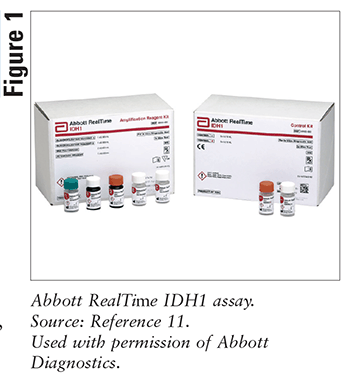US Pharm. 2019;44(9):HS11-HS12.
Acute myeloid leukemia (AML) is a type of cancer that proliferates in bone marrow and—in many cases—spreads quickly into the blood.1 Although stem cells generally develop into lymphocytes or myeloid cells, myeloid cells can potentially progress to malignancy during differentiation, resulting in AML.1 Symptoms of AML include fever, pancytopenia, fatigue, anorexia, and weight loss.
Epidemiology
According to the American Cancer Society, AML is one of the most common forms of leukemia in adults. In 2018, the ACS reported that AML was the cause of approximately 10,680 deaths in the United States.2-4 Data also suggest that the prevalence of AML increases with age; the median age of affected individuals is 67 years.3 Additionally, AML is approximately 30% more prevalent in males, and Caucasians are at higher risk compared with persons of other races.4,5
Etiology
The isocitrate dehydrogenase 1 (IDH1) gene provides instructions for producing the IDH1 enzyme, which is found in the cytoplasm of cells. The IDH1 gene yields several molecules, one of which is nicotinamide adenine dinucleotide phosphate (NADPH).6 NADPH’s primary responsibility is to produce energy and protect cells from harmful molecules, such as the reactive oxygen species. Ultimately, mutations in the IDH1 gene instigate a cascade of events that trigger the malignant transformation of affected cells.
Management
AML is currently managed with chemotherapy, biological agents, and stem-cell transplantation.7 The standard treatment in patients younger than age 60 years is a continuous infusion of cytarabine and administration of an anthracycline, such as idarubicin or daunorubicin. In patients aged 60 years and older, therapy is based on the Eastern Cooperative Oncology Group (ECOG) performance status scale. Developed by one of the largest clinical cancer research organizations in the U.S., this scale determines prognosis and the patient’s ability to tolerate chemotherapy during serious illness. After the patient’s ECOG status has been determined, chemotherapy should be accompanied by bone marrow biopsy, consolidation, and maintenance therapy.7-10
During treatment, aspiration of bone marrow is an integral part of monitoring procedures. Bone marrow aspiration and biopsy may be used to diagnose, monitor, and classify progression of cancers such as leukemia, lymphoma, and multiple myeloma.9,10 Because treatment options are largely dependent on determination of genetic mutations, additional testing may be required to ascertain the most effective modality.10
Abbott RealTime IDH1
The Abbott RealTime IDH1 (FIGURE 1) assay is a diagnostic test used in patients with AML. It employs polymerase chain reaction technology with homogeneous fluorescence detection to identify IDH1 alterations.6 Abbott RealTime IDH1 can detect five genetic metamorphoses and identify mutation levels of 2% and higher.11 The genetic changes identified by Abbott RealTime IDH1 include R132C, R132H, R132G, R132S, and R132L.12

The fundamental goal of Abbott RealTime IDH1 is to determine whether ivosidenib, an IDH1 inhibitor, is an appropriate treatment option for patients with AML. Ivosidenib reduces the abnormal production of the oncometabolite 2-hydroxyglutarate, which results in the differentiation of malignant cells.4 To ascertain whether the drug is appropriate for a patient, a sample of bone marrow or blood must be obtained to detect the presence of an IDH1 mutation. If the mutation is detected, the clinician can then decide whether administration of ivosidenib is suitable. The use of ivosidenib resulted in remission in some of the patients studied, and it also led to a reduction in the number of blood transfusions necessary.
The efficacy and safety of Abbott RealTime IDH1 were demonstrated in Study AG120-C-001, which was conducted to examine the effectiveness of ivosidenib treatment in adult AML patients receiving 500 mg daily of the drug.12 Abbott RealTime IHD1 was used to retrospectively confirm the gene mutations in patients’ specimens. Ivosidenib 500 mg daily was administered to the 174 patients. Complete remission and partial hematologic recovery rates were 24.7% and 8%, respectively, and the best response occurred within approximately 2 months of administration. Additionally, 41 of 110 patients were no longer dependent on RBC and platelet transfusions during the 56-day post-baseline period. It was concluded that Abbott RealTime IDH1 can accurately identify the specific IDH1 mutations in blood or bone marrow specimens of patients with AML and that data supported the reasonable assurance of the assay’s safety.12
Conclusion
Abbott RealTime IDH1 employs polymerase chain reaction technology with homogeneous fluorescence detection to identify IDH1 alterations. The prompt detection of mutations assists the clinician in determining whether ivosidenib may be effectively used as a treatment option. More information on this diagnostic test may be found online at www.molecular.abbott/us/en/products/oncology/realtime-idh1.
REFERENCES
1. American Cancer Society. What is acute myeloid leukemia (AML)? www.cancer.org/cancer/acute-myeloid-leukemia/about/what-is-aml.html. Accessed August 20, 2019.
2. American Cancer Society. Key statistics for acute myeloid leukemia (AML). www.cancer.org/cancer/acute-myeloid-leukemia/about/key-statistics.html. Accessed August 20, 2019.
3. Howlader N, Noone AM, Krapcho M, et al, eds. SEER Cancer Statistics Review, 1975-2012. Bethesda, MD: National Cancer Institute; 2015.
4. Seung AH, Dabb A. Acute leukemias. In: DiPiro JT, Talbert RL, Yee GC, et al, eds. Pharmacotherapy: A Pathophysiologic Approach. 10th ed. New York, NY: McGraw-Hill Education; 2017.
5. American Cancer Society. Cancer facts & figures 2018. www.cancer.org/content/dam/cancer-org/research/cancer-facts-and-statistics/annual-cancer-facts-and-figures/2018/cancer-facts-and-figures-2018.pdf. Accessed August 20, 2019.
6. Genetics Home Reference. IDH1 gene. https://ghr.nlm.nih.gov/gene/IDH1. Accessed August 20, 2019.
7. Schiffer CA, Gurbuxani S. Clinical manifestations, pathologic features, and diagnosis of acute myeloid leukemia. UpToDate. www.uptodate.com/contents/clinical-manifestations-pathologic-features-and-diagnosis-of-acute-myeloid-leukemia. Accessed August 20, 2019.
8. FDA. FDA approves first targeted treatment for patients with relapsed or refractory acute myeloid leukemia who have a certain genetic mutation. www.fda.gov/NewsEvents/Newsroom/PressAnnouncements/ucm614115.htm?utm_campaign=07202018_PR_FDA approves new AML drug&utm_medium=email&utm_source=Eloqua. Accessed August 20, 2019.
9. Mayo Clinic. Bone marrow biopsy and aspiration. www.mayoclinic.org/tests-procedures/bone-marrow-biopsy/about/pac-20393117. Accessed August 20, 2019.
10. Cancer.Net. Bone marrow aspiration and biopsy. www.cancer.net/navigating-cancer-care/diagnosing-cancer/tests-and-procedures/bone-marrow-aspiration-and-biopsy. Accessed August 20, 2019.
11. Versiti. IDH1 Abbott RealTime PCR. www.versiti.org/Custom/Files/Versiti/22/22adb1c0-60a4-4b51-8036-b1ed19b9b9b3.pdf. Accessed August 20, 2019.
12. Summary of safety and effectiveness data (SSED). www.accessdata.fda.gov/cdrh_docs/pdf17/P170041B.pdf. Accessed August 20, 2019.
To comment on this article, contact rdavidson@uspharmacist.com.






